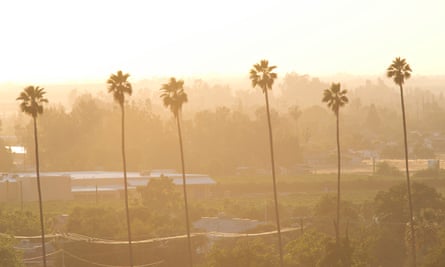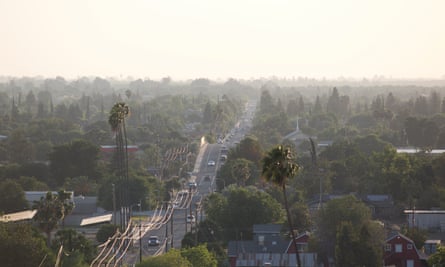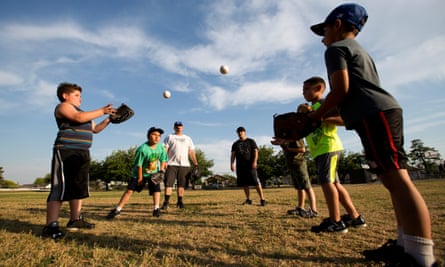Jose Velasquez, weary from picking cherries, was heading home on a battered bike this week with signs of a tough day etched across his face: dust, sunburn and little red marks all over.
And now a reporter is telling the 35-year-old that the World Health Organisation had just identified this baked corner of California as having the country’s worst air pollution.
“Really?” Velasquez sighed, tipping up his hat. Then he shrugged. Of all life’s challenges – feeding his family and paying rent top of the list – this seemed less urgent.
“The pollution is really bad, sure. But I don’t have a problem with it. Today I had thousands of ants on me, biting me everywhere. I had to throw my sweater in the garbage.”
You might think landing on the nation’s pollution top spot would upset the residents of Visalia-Porterville, an agricultural valley between San Francisco and Los Angeles. You might think laborers who work outdoors, inhaling the contaminated the air, would be angriest. Pollution is blamed for high rates of cancer, asthma and hundreds of premature deaths each year.
But in interviews, laborers and other residents expressed resignation. The air is bad? Yep. And the poverty is worse.
Carmen Perez, 59, who clips vine leaves, said she spent two weeks in hospital last year with a throat infection and fever. Once back on her feet, she immediately returned to the vineyards, where she has worked for 15 years earning minimum wage. Her six children work there too. “We all get coughs and other problems. A lot of phlegm.”
Asked about possible solutions, Perez, a migrant from Mexico who speaks only Spanish, did not consider pollution reduction measures. “Masks. We’d like some masks.” She mulled a bit more. “And gloves. Gloves would be great.”
Appearances can deceive in the San Joaquin valley, a stretch of fertile farmland that grows much of the US’s fruits, nuts and vegetables – earning it the nickname “America’s salad bowl”. From certain hilltops the landscape can appear an Eden.
But up close you can see the drought-baked soil and intensive irrigation, and can often smell the chemicals and pesticides.
On bad days you see the haze and feel the sting in your throat, revealing nature’s trick: the topography acts as a bowl and temperature inversion acts as a lid, trapping tainted air. Multiple sources contribute: farming and oil drilling; traffic on Interstate 5 and Highway 99; winds blowing contaminants from the bay area, Los Angeles and even Asia.

The WHO report published on Thursday said outdoor air pollution had grown 8% globally in the past five years, with billions of people now exposed to dangerous air.
The United Nations’ health agency linked Visalia and Porterville, two small cities 30 miles apart in the San Joaquin valley, to identify the US’s dirtiest urban center.
Visalia’s official website shows bucolic scenery and the motto “gateway to the sequoias”, while Porterville has emblazoned its name on walls, proclaiming it an “all-American city”.
Haze may be a more apt symbol, as doubts hang over efforts to counter pollution. Officially the result is a huge success. But some critics consider the campaign a mirage.
The San Joaquin valley air pollution control district, a 15-member board comprising mainly elected officials, heads the clean-up under the motto “leading the way to a clearer future”.
In an interview Seyed Sadredin, the executive director, said that since 1980 the region had reduced pollutants that form ozone and particulate matter by 80% – a credit to local businesses, notably agriculture and oil, which spent $40bn and absorbed more than 600 regulations. “We have the most stringent regulations in the US.”

But some health and environmental advocates dispute this narrative and say that, in reality, the air pollution control district represents business interests that prize profits over clean air.
“They are conspiring to change the standards so things don’t look as dirty as they are,” said Kathryn Phillips, the director of Sierra Club California.
Tom Frantz, a farmer and veteran environmental activist, said the district reflected the valley’s Republican-led establishment, which was funded by local industry. “They don’t represent the poor farm workers who are out in the fields. They downplay the harm that air pollution causes.”
Kevin Hamilton, a respiratory therapist who heads the Central California Asthma Collaborative, said the district acted only when compelled by litigation, and even then tried to protect corporate interests, creating “loopholes in the law that you can drive a truck through”.
Critics say the authority has revealed its true colors by backing the Clean Air Act modernisation bill, which they consider an attempt to lower standards and weaken protections. It is sponsored by Republican Kevin McCarthy, the US House majority leader. He is from Bakersfield, part of the San Joaquin valley.
Sadredin, the air pollution control district’s executive director, said the bill was a sensible attempt to update 46-year-old legislation which creates costly bureaucracy.
He denied being an industry shill and said critics were misguided. “There is an extremist minority that basically always claims the sky is falling without recognising improvements.”
Bonnie Holmes-Gen, senior director of air quality and climate change at the American Lung Association in California, agreed that big drops in bad ozone and particle days showed important progress. But she lamented the district was resisting federal clean air standards: “We don’t agree with that.” The association gave the valley an F in its annual “state of the air” report.
The valley has the US’s highest asthma rate for children, delivering a stream of patients to Nabil Abbassi, a doctor at a clinic for low-income residents in Delano run by the nonprofit Clinica Sierra Vista. “They complain they are exposed to dust and fumes,” said Abbassi. “Unfortunately there’s not much they can do about it.”

On a recent day in Porterville, half a dozen boys played baseball in a park as dusk approached; a glimpse of apparent normality, but it turned out that half the team was missing. “There’s about six kids at home. Summer’s coming so even on a good day it can be hard for some of them to breathe,” said the coach, Matthew O’Neal.
Abe Giron, 35, a father watching from the sidelines, counted himself and his son lucky. His grandfather and father labored in the fields so that he, the third generation, could go to college and get a good job as a state hospital nurse.
“The ones who work outdoors, who pick our fruits and vegetables, they’re the ones paying the price of pollution.” They would continue to do so, said Giron, because they had no choice. “Not going out to work, that’s not an option.”

Comments (…)
Sign in or create your Guardian account to join the discussion